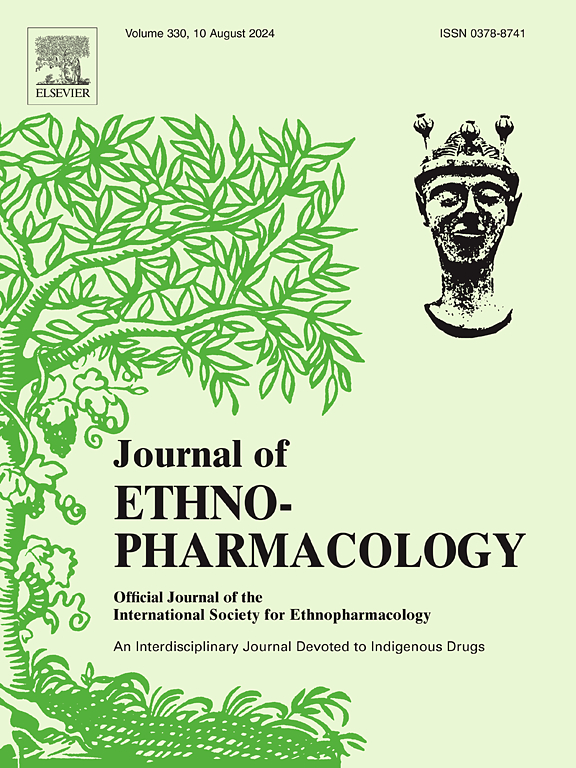Zhen-wu-tang alleviates nephrotic syndrome by upregulating 5-HTR1B to activate AMPK/PGC-1α-mediated mitochondrial biogenesis
IF 5.4
2区 医学
Q1 CHEMISTRY, MEDICINAL
引用次数: 0
Abstract
Ethnopharmacological relevance
Zhen-wu-tang (ZWT) as a classic herbal formula is widely recognized for its therapeutic efficacy in treating nephropathy. It is commonly used to alleviate edema, improve renal function, and manage symptoms associated with kidney yang deficiency. However, its therapeutic efficacy and mechanism for nephrotic syndrome (NS) is not yet clear.
Aim of the study
To investigate the underlying mechanism of ZWT in regulating mitochondrial biogenesis (MB) to treat NS.
Methods
An adriamycin (ADR)-induced NS animal model and a renal tubular epithelial cell injury model were used, followed by intervention with three concentrations of ZWT. The location of 5-HTR1B in kidney cells was observed using immunofluorescence co-localization. Protein levels of the MB-related proteins, including recombinant transcription factor A (TFAM), peroxisome proliferator-activated receptor γ coactivator 1α (PGC-1α), adenosine 5′-monophosphate-activated protein kinase (AMPK) and p-AMPK, were determined by western blotting after administration of 5-hydroxytryptamine receptor 1B (5-HTR1B) agonist and inhibitor interventions. The bioactive compounds of ZWT-containing serum were determined using ultra-performance liquid chromatography quadrupole time-of-flight mass spectrometry.
Results
ZWT treatment ameliorated renal dysfunction and pathological damage in NS rats by attenuating podocyte and tubular cell damage. Additionally, ZWT reduced NS-induced mitochondrial dysfunction and reactive oxygen species levels. Immunofluorescence revealed that 5-HTR1B was predominantly expressed in the collecting ducts and proximal tubule cells. In ADR-induced models, ZWT upregulated the levels of PGC-1α, TFAM, AMPK and p-AMPK proteins involved in MB. In addition, a novel finding was that both gene and protein levels of 5-HTR1B were downregulated in these injury models, whereas ZWT intervention upregulated them. Studies on 5-HTR1B agonists and antagonists indicated that ZWT regulates AMPK/PGC-1α through 5-HTR1B-mediated mechanisms. Furthermore, 24 bioactive compounds were identified in ZWT-containing serum, of which paeoniflorin bound best to 5-HTR1B and acted similarly to 5-HTR1B agonists.
Conclusion
Overall, this study demonstrated that ZWT alleviates NS by upregulating MB via the 5-HTR1B/AMPK/PGC-1α signaling. This novel mechanism enriches the reference of ZWT for NS therapy.

珍乌汤通过上调5-HTR1B激活AMPK/ pgc -1α介导的线粒体生物发生,缓解肾病综合征
中药真乌汤作为一种经典的中药方剂,其治疗肾病的疗效得到了广泛的认可。常用于减轻水肿,改善肾功能,治疗肾阳虚症状。然而,其治疗肾病综合征(NS)的疗效和机制尚不清楚。目的探讨ZWT调节线粒体生物发生(MB)治疗NS的潜在机制。方法采用ADR诱导的NS动物模型和肾小管上皮细胞损伤模型,然后用三种浓度的ZWT进行干预。采用免疫荧光共定位法观察5-HTR1B在肾细胞中的位置。在给予5-羟色胺受体1B (5- htr1b)激动剂和抑制剂干预后,通过western blotting检测mb相关蛋白的蛋白水平,包括重组转录因子A (TFAM)、过氧化物酶体增殖体激活受体γ共激活因子1α (PGC-1α)、腺苷5 ' -单磷酸活化蛋白激酶(AMPK)和p-AMPK。采用超高效液相色谱-四极杆飞行时间质谱法测定含zwt血清的生物活性成分。结果zwt通过减轻足细胞和小管细胞的损伤,改善了NS大鼠的肾功能和病理损害。此外,ZWT还能降低ns诱导的线粒体功能障碍和活性氧水平。免疫荧光显示5-HTR1B主要表达于集合管和近端小管细胞。在adr诱导的模型中,ZWT上调了与MB相关的PGC-1α、TFAM、AMPK和p-AMPK蛋白的水平。此外,一项新的发现是,在这些损伤模型中,5-HTR1B的基因和蛋白水平均下调,而ZWT干预上调了它们。对5-HTR1B激动剂和拮抗剂的研究表明,ZWT通过5-HTR1B介导的机制调节AMPK/PGC-1α。此外,在含zwt的血清中鉴定出24种生物活性化合物,其中芍药苷与5-HTR1B结合效果最好,作用与5-HTR1B激动剂相似。综上所述,本研究表明ZWT通过5-HTR1B/AMPK/PGC-1α信号通路上调MB,从而缓解NS。这一新的机制丰富了ZWT治疗NS的参考依据。
本文章由计算机程序翻译,如有差异,请以英文原文为准。
求助全文
约1分钟内获得全文
求助全文
来源期刊

Journal of ethnopharmacology
医学-全科医学与补充医学
CiteScore
10.30
自引率
5.60%
发文量
967
审稿时长
77 days
期刊介绍:
The Journal of Ethnopharmacology is dedicated to the exchange of information and understandings about people''s use of plants, fungi, animals, microorganisms and minerals and their biological and pharmacological effects based on the principles established through international conventions. Early people confronted with illness and disease, discovered a wealth of useful therapeutic agents in the plant and animal kingdoms. The empirical knowledge of these medicinal substances and their toxic potential was passed on by oral tradition and sometimes recorded in herbals and other texts on materia medica. Many valuable drugs of today (e.g., atropine, ephedrine, tubocurarine, digoxin, reserpine) came into use through the study of indigenous remedies. Chemists continue to use plant-derived drugs (e.g., morphine, taxol, physostigmine, quinidine, emetine) as prototypes in their attempts to develop more effective and less toxic medicinals.
 求助内容:
求助内容: 应助结果提醒方式:
应助结果提醒方式:


